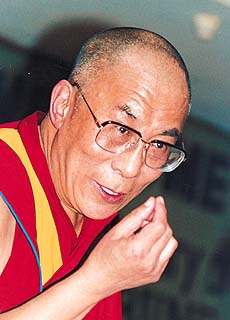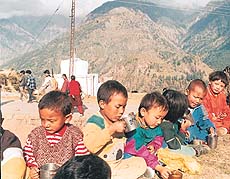Struggle
without a pause
By Anupama
Mahajan
THE struggle of Tibet started in
1949 when the troops of the People’s Liberation Army
of China invaded Tibet. This invasion was against the
international law. But till today nothing substantive
could be done to alleviate Tibet’s problems and give
it it’s rightful freedom. Even though 190 heads of
state gathered in New York in October, 1995, to
commemorate the 50th anniversary of the United Nations,
the body founded to preserve peace and promote justice,
the real world was outside which was neglected and
divorced. This violation of human rights and
international law is not being given any kind of
consideration by the UN though the whole world presently
supports Tibet’s cause.
 To answer the question of Tibet’s
international status it is of utmost importance to
understand its past relations with China and other
countries. To answer the question of Tibet’s
international status it is of utmost importance to
understand its past relations with China and other
countries.
The history of the Tibetan
state dates back to 127 B.C. with the establishment of
the Yarlung Dynasty. Tibet was one of the most
indomitable powers of Asia for the three centuries that
followed. So much so, that it defeated China in the 8th
century, and in disgrace the Chinese emperor had to flee.
This rivalry kept on ensuing for the next quarter of a
century. The proof of this is given on an inscription on
a stone pillar in Lhasa.
The Chinese entered into a
peace treaty which is known as the Treaty of Chi’ing
— Shui, demarcating the boundaries between the two
countries. But in 1209 Tibet was invaded by the army of
Chengis Khan of Mongolia for the first time. It continued
with his grandson Godan Khan and consequently Sakya
Pandita and later Yuan dynasty. In the 14th century, the
Tibetan Lamas became the teachers of the Chinese emperor.
The great tradition of the Lamas began with the title
being conferred on Lama Sonam Gyatsa. Around 16th century
Lozang Chosgyan was recognised as the first Panchan Lama
(meaning great scholar) and thereafter his reincarnations
inherited this title. The first Dalai Lama was Sonam
Gyatsa, known as Panchan Gedun Dupa, till the present
Dalai Lama, who is the 14th Dalai Lama.
After a long period of a
series of invasions by turn by the Gorkhas, the Sikhs and
Britain, Tibet reasserted its freedom in 1913 after the
downfall of the Manchu emperor. The independence of Tibet
was thus fully recognised by China.
The government of Tibet
was headquartered in Lhasa, the capital city of Tibet. It
consisted of a head of state (the Dalai Lama), a cabinet
of ministers (the Kashag), a national assembly (the
Tsongdu), an extensive bureaucracy and a judicial system
to administer the vast territory of Tibet. The government
of Tibet levied taxes, minted its own currency, ran the
country’s postal system and issued postal stamps.
In 1959, Tibet was an
independent state when China invaded with an army of
40,000 troops. The small Tibetan force, consisting of
8,000 militia was defeated, as a result of which 4,000
Tibetan fighters were killed. After this the Chinese
destroyed what came in their way. In 1951 the Tibetan
government sent a five-member Committee to Beijing but
nothing came out of it. The Chinese made them sign a
17-point agreement under duress without their being able
to inform the Tibetan government. The delegation warned
the Chinese that this agreement was being signed because
of blackmail and the Dalai Lama was not bound by it. This
agreement empowered the Chinese government to enter with
its army men and to handle Tibet’s external affairs.
The Dalai Lama heard of all this on Radio Beijing on May
27, 1951, for the first time and reacted with shock.
 The Chinese slaughtered tens of
thousands of Tibetans. They took this opportunity to
snatch away thousands to tonnes of barely and other
foodstuffs which brought about famine-like situation. The
Dalai Lama, in 1956, went to India to talk about
political asylum in India, but Jawaharlal Nehru convinced
him to return home and talk to the Chinese government. The Chinese slaughtered tens of
thousands of Tibetans. They took this opportunity to
snatch away thousands to tonnes of barely and other
foodstuffs which brought about famine-like situation. The
Dalai Lama, in 1956, went to India to talk about
political asylum in India, but Jawaharlal Nehru convinced
him to return home and talk to the Chinese government.
The inevitable
confrontation came about in March 1959. There was a
general scare that the Dalai Lama might be abducted.
When all avenues for
negotiations seemed to be shut, the Dalai Lama decided to
escape to India to appeal for international help to save
his people. He left Lhasa on March 17, 1959, and
re-established the Tibetan government in-exile in
Dharamsala and declared: "Wherever I am, accompanied
by my government, the Tibetan people recognise us as the
government of Tibet." More than 80,000 Tibetans
crossed the border and reached India.
Killings and destruction
followed this uprising. The scenes of death and homicide
were horrible with dead bodies rolling down the hills
into ditches. All these atrocities have wounded deeply
the hearts and minds of Tibetans. Deaths in prisons and
labour and concentration camps increased so much that the
figures touched 8,000 in a year. The bodies were disposed
off in the river or burnt. According to information
compiled by the Tibetan government-in-exile, over 1.2
million Tibetans died between 1949 and 1979.
Tibet has always been an
extremely religious nation since the early days. Buddhism
has not been a mere system of belief to the Tibetans, it
encompasses the entirety of their culture and
civilisation and constitutes the very essence of their
lives. Buddhism permeated the very daily lives of the
Tibetan people. In 1959 there were 6,259 monasteries with
about 5,92,558 resident monks and nuns. These religious
centres were housed with statues of gold and silver and
studded with various jewels. Also, they became
storehouses of works on literature, medicine, astrology,
art, politics, etc.
Tibetan national identity
became indistinguishable from its religion. Tibet became
a proud Buddhist nation till the Chinese occupation. The
Chinese, even though they promised in the 17-point
programme, to protect the religious tradition, did not
stick to it. They soon succumbed to the strong viewpoint
of Mao Zedong that "religion is poison".
Even though the Chinese
assert that they did not, but much of Tibetan culture and
religion was destroyed between 1955 and 1961. The monks
and nuns were humiliated in public and physically
debarred. Sacrilege of temples became a common sight. Out
of 6,259 monasteries and nunneries, only about eight
remained by 1976.
Though the Chinese
government claims to have reconstructed the religious
monuments, this has only served the purpose of promoting
tourists. And, moreover, this was done with the
Tibetans’ financial and physical help. The money
which is collected through charging entry fees as well as
offerings made by the pilgrims is being collected by the
Chinese government.
Though the Chinese
government does not attack Tibet’s monasteries any
longer, it still opposes religion. But religion is the
main spiritual force behind Tibetans. Recently also, in
the New Year celebrations, the Dalai Lama performed the
famous oracle ceremony, in which a spirit enters the body
of those persons who act as a medium, between the natural
and spiritual realms. This phenomenon has defied
scientific investigation and scrutiny so far.
The 17-point agreement on
the peaceful liberation of Tibet has been refuted by the
Dalai Lama after he fled Tibet in 1959. He could not
renounce it earlier as it was imposed on the basis of
sheer brute force. Though the Chinese claim that they
have included Tibet as an important component of the
Chinese peoples’ liberation cause, Tibet, over the
past 43 years, has gone through sweeping changes from the
serf system to modernisation.
The Dalai Lama very
rightly asserts that "the options on the matter of
future status of Tibet are open but the fact that Tibet
was an independent nation made captive by China cannot be
wiped out."
According to a Chinese
government’s spokesman, the Dalai Lama is a Chinese
citizen and should abandon the idea of an independent
Tibet and return to China for his remaining years. But
the freedom to Tibet cannot be denied.
In present-day world, no
country can invade another like barbarians and take over
the conquests and do whatever it likes. The Dalai Lama
has been trying with all his effort for the uplift of his
fellow countrymen as well as women. Tibetan women have
played a leading role in the Tibetan national movement
and have always rebelled against the Chinese colonial
role in Tibet, as a result of which they have been
arrested. Some of them have suffered torture and abuse in
police custody.
The Dalai Lama encourages
women to participate in the administration at all levels
in the ‘Tibetan administration’. The women in
Tibet enjoy none of the human rights and freedom that are
taken for granted in exile. Today one-third of the
workforce in the Tibetan government-in-exile consists of
women. In 1988 a Tibetan woman was appointed as one of
Dalai Lama’s overseas representative.
The crusade of Tibetans
continues even after so many years. The Dalai Lama was
asked recently in a television programme why he
didn’t go to Tibet and fight for his rights like
Nelson Mandela and Mahatma Gandhi. But to this query, his
reply was that he believed in peaceful ways and means
without any violence. He wants to have talks and resolve
the issue of total independence. The Dalai Lama has
repeatedly made a number of proposals to the Chinese
Government for negotiations, but sadly these were not
reciprocated by China. The Chinese have maintained that
talks can be held on any subject except total
independence of Tibet. The Chinese refuse to even come to
the negotiating table for other causes. This desire for a
peaceful situation has won the Dalai Lama the Nobel Peace
Prize and other numerous awards.
|

